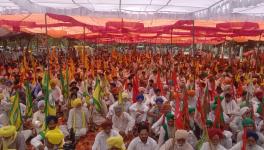Dupe and Dole: The Algebra of MSP and PM KISAN Grants

Image Courtesy: Wikimedia Commons
Two recent announcements by the government addressed the farmers – one notified the Minimum Support Prices (MSP) for kharif (monsoon) crops this year, while the other announced that Rs.2.42 lakh crore had been disbursed to 11 crore farmers under the PM KISAN scheme. Both appear to be measures meant to help the farmers by boosting their incomes. But the reality is different. On the one hand, the Narendra Modi government is setting MSPs far below what it had promised itself back in 2014, thus depriving farmers of thousands of crore rupees. On the other hand, it is giving a grant of Rs.6,000 per year to farmers under the PM KISAN scheme. As shown below, the grants do not compensate for continued loss from crop incomes, year after year.
Calculations show that between 2015-16 and 2022-23, farmers have been denied a whopping Rs.2,37,427 crore owing to lower MSP of rice and Rs.58,460 crore on account of lower MSP of wheat. That adds up to a total loss of Rs. 2,95,887 crore, or nearly Rs.3 lakh crore. Note that this is only for two key staples. If one was to add the other 12 agricultural produce that are supposed to be bought for respective declared MSPs, the loss would go up further. The loss farmers have suffered is more than the amount given to them under the PM KISAN scheme.
The Loss
In 2014, PM Modi had promised that it would implement the recommendation given by National Farmers’ Commission, headed by eminent agriculture scientist M.S.Swaminathan. The Commission had recommended that MSP should be 50% more than the comprehensive cost of production, denoted as C2 in the scientists’ notation.
However, the Modi government has conveniently settled for calculating MSPs based on a modified cost of production that does not include several important components and hence falls short of C2. This modified cost includes all input costs (A), imputed family labour (FL) costs and some other items but omits costs of capital outlays, rents etc. MSP is calculated by adding 50% to this modified cost of production.
Let us take the latest case of rice and wheat procured by the government at declared MSPs. In 2022-23, the MSP for rice was pegged at Rs.2,040 per quintal (110 kg). The government procured 534 lakh tonnes of rice at this rate. This gives us the total returns to farmers who sold to government as Rs.1.09 lakh crore.
What would have been the cost if this rice was procured at C2+50%, the Swaminathan Commission recommendation? The answer can be found by taking the C2 cost as recorded by the Commission for Agricultural Costs and Prices (CACP), a body functioning under the agriculture ministry. It pegs the C2 cost for rice in 2022-23 at Rs.1,805/quintal. If MSP for rice is fixed at C2+50% then it should have been Rs.1,805+903, that is, Rs.2,708. If the government bought the same quantity of rice (534 lakh tonnes) at this rate, farmers would have got Rs.1.5 lakh crore.
The difference between what the farmers could get if the Swaminathan Commission recommendation was implemented and what they actually got, is a massive Rs.35,651 crore. And this is only for one year -- 2022-23. If you do the same calculation for each year, then between 2015-16 and 2022-23, rice farmers have cumulatively lost Rs.2.37 lakh crore.
A similar calculation for wheat shows that between 2015-16 and 2023-24, farmers have lost Rs.58,460 crore.
See Appendix below for detailed calculations.
Loss is More for Farmers Selling in Open Market
What remains difficult to calculate is the loss suffered by farmers who are not able to sell to the government and usually end up getting less than MSP prices for their produce. Only a fraction of the produce is bought by the government and the guarantee of MSP exists only for such transactions. For example, in 2022-23, rice production was estimated at 1,355.4 LMT (lakh metric tonnes) but government procurement was just 534 LMT. That’s only about 40% of the total production. The remaining 60% is either kept by the farmers for self-consumption or sold in the open market at prices lower than declared MSPs. Successive reports of CACP confirm that this is what happens.
One of the factors determining open market prices is MSP. Farmers and traders tend to look at the MSP level to bargain and settle for prices, although usually traders have more clout in pushing it down. Most farmers who sell to traders rather than to government agencies are small and in need of quick cash. They do not have much bargaining strength. The only crutch they have is the MSP fixed by the government.
So, lower MSPs tend to lower the sale prices across the board, even for farmers selling to private traders. The quantum of these sales and the prices they get vary from place to place and are difficult to track or record. But it can incontrovertibly be said that lower MSPs would lower the open market prices.
By keeping the MSP low, the government is not only saving on its own resources (which are actually public resources!) but importantly, it is benefitting the whole big traders’ class that buys up foodgrains at lower prices from hapless farmers.
The government is willing to spend its funds on a scheme for giving dole to farmers and making political-electoral capital out of it, extolling its own care and concern for the ‘annadatas’ (food grain providers), rather than ensuring that farmers get a better price from the traders or from the government itself.
Appendix
Get the latest reports & analysis with people's perspective on Protests, movements & deep analytical videos, discussions of the current affairs in your Telegram app. Subscribe to NewsClick's Telegram channel & get Real-Time updates on stories, as they get published on our website.
























